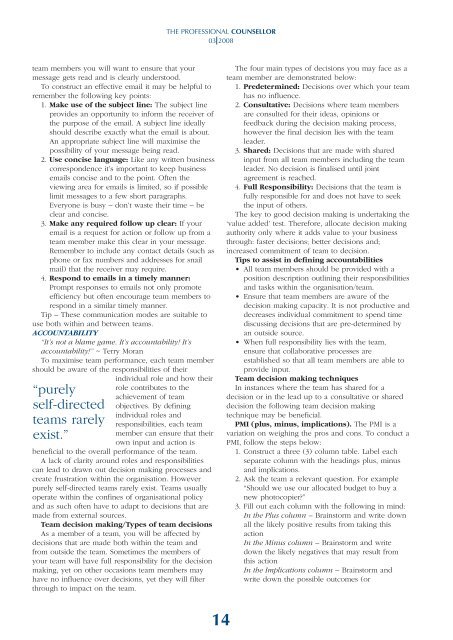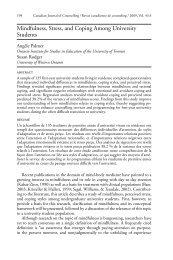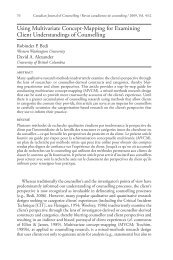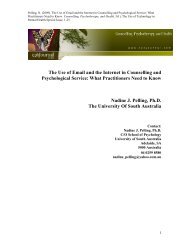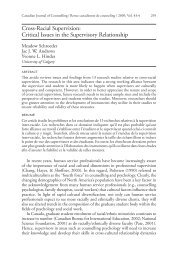PROFESSIONAL COUNSELLOR - Mental Health Academy
PROFESSIONAL COUNSELLOR - Mental Health Academy
PROFESSIONAL COUNSELLOR - Mental Health Academy
Create successful ePaper yourself
Turn your PDF publications into a flip-book with our unique Google optimized e-Paper software.
THE <strong>PROFESSIONAL</strong> <strong>COUNSELLOR</strong><br />
03 2008<br />
team members you will want to ensure that your<br />
message gets read and is clearly understood.<br />
To construct an effective email it may be helpful to<br />
remember the following key points:<br />
1. Make use of the subject line: The subject line<br />
provides an opportunity to inform the receiver of<br />
the purpose of the email. A subject line ideally<br />
should describe exactly what the email is about.<br />
An appropriate subject line will maximise the<br />
possibility of your message being read.<br />
2. Use concise language: Like any written business<br />
correspondence it’s important to keep business<br />
emails concise and to the point. Often the<br />
viewing area for emails is limited, so if possible<br />
limit messages to a few short paragraphs.<br />
Everyone is busy – don’t waste their time – be<br />
clear and concise.<br />
3. Make any required follow up clear: If your<br />
email is a request for action or follow up from a<br />
team member make this clear in your message.<br />
Remember to include any contact details (such as<br />
phone or fax numbers and addresses for snail<br />
mail) that the receiver may require.<br />
4. Respond to emails in a timely manner:<br />
Prompt responses to emails not only promote<br />
efficiency but often encourage team members to<br />
respond in a similar timely manner.<br />
Tip – These communication modes are suitable to<br />
use both within and between teams.<br />
ACCOUNTABILITY<br />
“It’s not a blame game. It’s accountability! It’s<br />
accountability!” ~ Terry Moran<br />
To maximise team performance, each team member<br />
should be aware of the responsibilities of their<br />
individual role and how their<br />
“purely<br />
self-directed<br />
teams rarely<br />
exist.”<br />
role contributes to the<br />
achievement of team<br />
objectives. By defining<br />
individual roles and<br />
responsibilities, each team<br />
member can ensure that their<br />
own input and action is<br />
beneficial to the overall performance of the team.<br />
A lack of clarity around roles and responsibilities<br />
can lead to drawn out decision making processes and<br />
create frustration within the organisation. However<br />
purely self-directed teams rarely exist. Teams usually<br />
operate within the confines of organisational policy<br />
and as such often have to adapt to decisions that are<br />
made from external sources.<br />
Team decision making/Types of team decisions<br />
As a member of a team, you will be affected by<br />
decisions that are made both within the team and<br />
from outside the team. Sometimes the members of<br />
your team will have full responsibility for the decision<br />
making, yet on other occasions team members may<br />
have no influence over decisions, yet they will filter<br />
through to impact on the team.<br />
The four main types of decisions you may face as a<br />
team member are demonstrated below:<br />
1. Predetermined: Decisions over which your team<br />
has no influence.<br />
2. Consultative: Decisions where team members<br />
are consulted for their ideas, opinions or<br />
feedback during the decision making process,<br />
however the final decision lies with the team<br />
leader.<br />
3. Shared: Decisions that are made with shared<br />
input from all team members including the team<br />
leader. No decision is finalised until joint<br />
agreement is reached.<br />
4. Full Responsibility: Decisions that the team is<br />
fully responsible for and does not have to seek<br />
the input of others.<br />
The key to good decision making is undertaking the<br />
‘value added’ test. Therefore, allocate decision making<br />
authority only where it adds value to your business<br />
through: faster decisions; better decisions and;<br />
increased commitment of team to decision.<br />
Tips to assist in defining accountabilities<br />
• All team members should be provided with a<br />
position description outlining their responsibilities<br />
and tasks within the organisation/team.<br />
• Ensure that team members are aware of the<br />
decision making capacity. It is not productive and<br />
decreases individual commitment to spend time<br />
discussing decisions that are pre-determined by<br />
an outside source.<br />
• When full responsibility lies with the team,<br />
ensure that collaborative processes are<br />
established so that all team members are able to<br />
provide input.<br />
Team decision making techniques<br />
In instances where the team has shared for a<br />
decision or in the lead up to a consultative or shared<br />
decision the following team decision making<br />
technique may be beneficial.<br />
PMI (plus, minus, implications). The PMI is a<br />
variation on weighing the pros and cons. To conduct a<br />
PMI, follow the steps below:<br />
1. Construct a three (3) column table. Label each<br />
separate column with the headings plus, minus<br />
and implications.<br />
2. Ask the team a relevant question. For example<br />
“Should we use our allocated budget to buy a<br />
new photocopier”<br />
3. Fill out each column with the following in mind:<br />
In the Plus column – Brainstorm and write down<br />
all the likely positive results from taking this<br />
action<br />
In the Minus column – Brainstorm and write<br />
down the likely negatives that may result from<br />
this action<br />
In the Implications column – Brainstorm and<br />
write down the possible outcomes (or<br />
14


